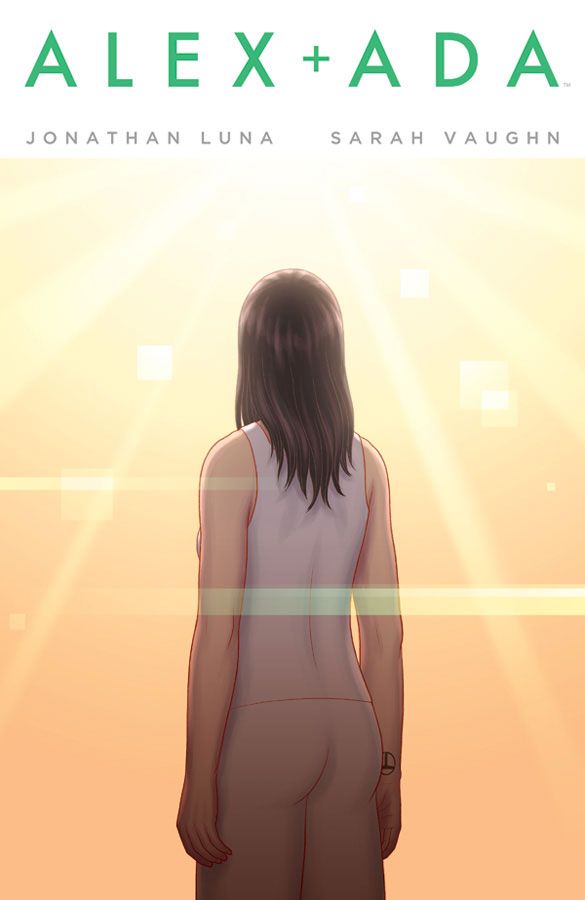In "Alex + Ada" #11 by Jonathan Luna and Sarah Vaughn, Alex and Ada's relationship is now moving forward, although the pacing still feels artificially fast. In early issues, the psychology of the relationship and the tentative feelings were believable, but in the rush to make action happen faster, some realism was sacrificed. The result is that the current flowers-and-hearts stage of the relationship feels a little forced. Alex's romance with Ada probably would have worked better with a slower build.
The tenderness in the relationship works. Luna's art tends to excel at subtleties more than in depicting passionate intensity. The best romantic moments in "Alex + Ada" #11 are the small, gestural ones like the body language in the scene where Alex is leaving for work.
Along with developing the main romance, "Alex + Ada" #11 also tries to further its main themes about robots, sentience and humanity. Luna and Vaughn weigh in on the old question of whether robots can dream. In the universe of "Alex + Ada," the answer is yes, but only if the robots are sentient, which is rather circular. Luna and Vaughn's robots with Prime Intelligence are morally indistinguishable from humans, even with their constructed origins and potentially heightened range of abilities. Ada's conversation with the Administrator of the Degrees of Freedom chat room feels contrived, but it's obviously placed there to drive home the idea that Ada's dreams, drives and reasons are much the same as any human: she wants to belong to and to contribute to society.
The theme of tolerance gets a similarly sincere but somewhat artificial dialogue between Alex and his grandmother. This exploration of morality is admirable, but it also takes away from the story because the dialogue isn't completely natural and is a bit too transparently didactic. The conversation doesn't fail utterly at being believable, but it also doesn't flow effortlessly and make its point at the same time.
Luna and Vaughn get it right in a sequence that pulls off the delicate balance of thematic development and emotional realism. At Emily's party, Alex's friend Isabel has a messy outburst. The dialogue and artwork in previous issues has made it clear that Isabel likes Alex romantically, and has been giving him space, waiting for him to get over his ex-girlfriend Claire. Ada's presence has taken her chance away. Isabel's hurt and anger is believable, even if it's equally obvious that she's being unfair and rude. The emotional turbulence builds quickly and believably through the dialogue, and the result is a riveting scene that also shows the reader the pressure on Alex and Ada's relationship due its taboo nature and her illegal status. Jacob's reaction is also well-done, and the awkward silence between him and Alex is familiar to anyone who's had a political and religious issue suddenly come up in conversation where a friend has opposing views. Showing the reader the moral context often takes much longer than telling, but it's far more effective storytelling.
Luna's backgrounds are still deliberately spare and spacious, giving the reader plenty of room to pick up on elegant shifts in panel composition and character placement. His subdued color palette is more drab than usual in "Alex + Ada" #11, but it works well for the overall tone and particularly for the final cliffhanger page, which has a horror-movie camera angle that is perfect for heightening suspense.
So far, everyone who knows about Ada's sentience has been trustworthy, but it's a natural extension of Luna and Vaughn's anti-sentience plot thread for someone close to Alex to be a threat to the secret of Ada's sentience. "Alex + Ada" #11 works up to reveal who this will be. It's not a huge surprise, and Luna and Vaughn even give the reader some room to empathize with Jacob, though that moral subtlety may swiftly be eliminated if Jacob behaves badly in a future issue, or even if he was responsible for Otto's suspicious accident.
Most of the unevenness of "Alex + Ada" in recent issues is due to rushed pacing, but the series is still worth picking up for the art and for the scenes in which the moral underpinnings are woven into with the drama.

